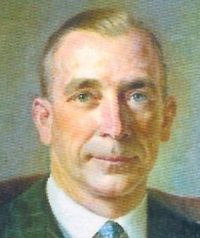First performed by McGill
Transvesical Prostatectomy
In 1827, whilst removing a bladder stone by the supra pubic route, Jean Amussat (1796 - 1856) of France, noticed a round tumour projecting from the bladder neck and snipped it off with scissors. This was almost certainly the middle lobe of the prostate and was probably the earliest recorded suprapubic partial prostatectomy.
In 1880, the Austrian surgeon Leopold von Dittel (1815-1890) similarly cut off a middle lobe that was "in the way" whilst placing a suprapubic catheter. In 1885, he deliberately reopened the bladder of a doctor who was suffering from BPH and could not cope with the pain of urethral catheterisation or a suprapubic drain. He removed the lobe with a snare but the patient died of sepsis six days later.
The procedure was carried out sporadically by various surgeons including Billroth and Trendelenberg in Germany.
Arthur McGill
(1850 - 1890)

McGill in Leeds was the first surgeon in Britain to perform open prostatectomy, on 24 March 1887. Other surgeons in Leeds also began to do this, in particular Mayo Robson.
It is clear that, in the 1880’s, McGill had completely enucleated the prostate, purposefully removing both the middle and lateral lobes in some patients.
William T Belfield
(1856 - 1929)

At about the same time, and completely independently, the American William Belfield (1856-1929) was doing the same procedure in Chicago.
In his 1890 paper, Belfield credited McGill with the original concept of total enucleation.
Eugene Fuller
(1858 - 1930)

Fuller of New York published a clear method of transvesical, complete enucleation of the benign prostate in 1895, and some feel that he originated this operation; it is, I believe, reasonable to say that McGill and Belfield were already doing total enucleation in some cases and partial median lobe prostatectomy in others.
Sir Peter Freyer published his paper in July 1901 claiming it as his idea. This caused a lot of anger and ill-feeling, both in America and in Leeds, where mention was made of the work of Fuller and McGill. However, in 1920, Freyer published a very large series (1625 cases) of suprapubic prostatectomy with a mortality rate of only 5%. He undoubtedly popularised this procedure but it is clear that he did not introduce it.
(1625 cases) of suprapubic prostatectomy with a mortality rate of only 5%. He undoubtedly popularised this procedure but it is clear that he did not introduce it.
Retropubic Prostatectomy
In 1908, van Stockum of Holland performed the first retropubic prostatectomy but he did not actively pursue this and the idea did not become popular. A few other surgeons tried it over the next few years but it did not become "mainstream" until Terence Millin published his technique in 1945.
Terence Millin carried out his first retropubic prostatectomy by approaching the prostate adenoma via the cavern of Retzius, rather than through the bladder, inspired, he said, by the technique of cystectomy.
Even though he was not the first to use this approach, like Freyer before him, it was Millin who popularised this procedure which became a standard technique and, indeed, remains so to this today for the open approach.
← Back to Prostate